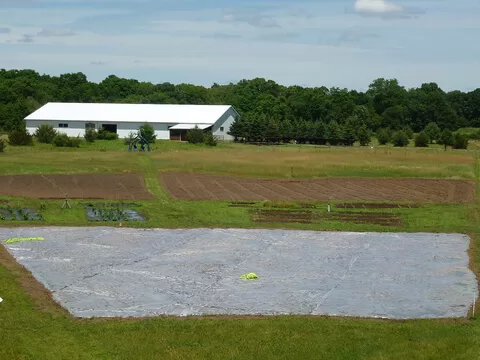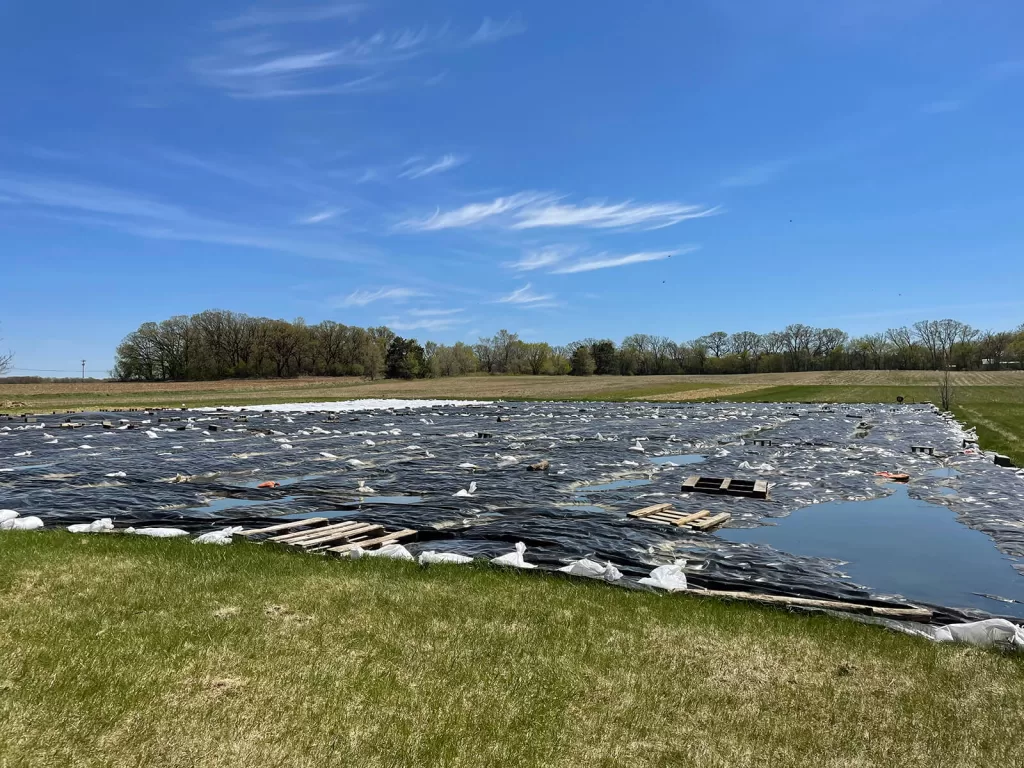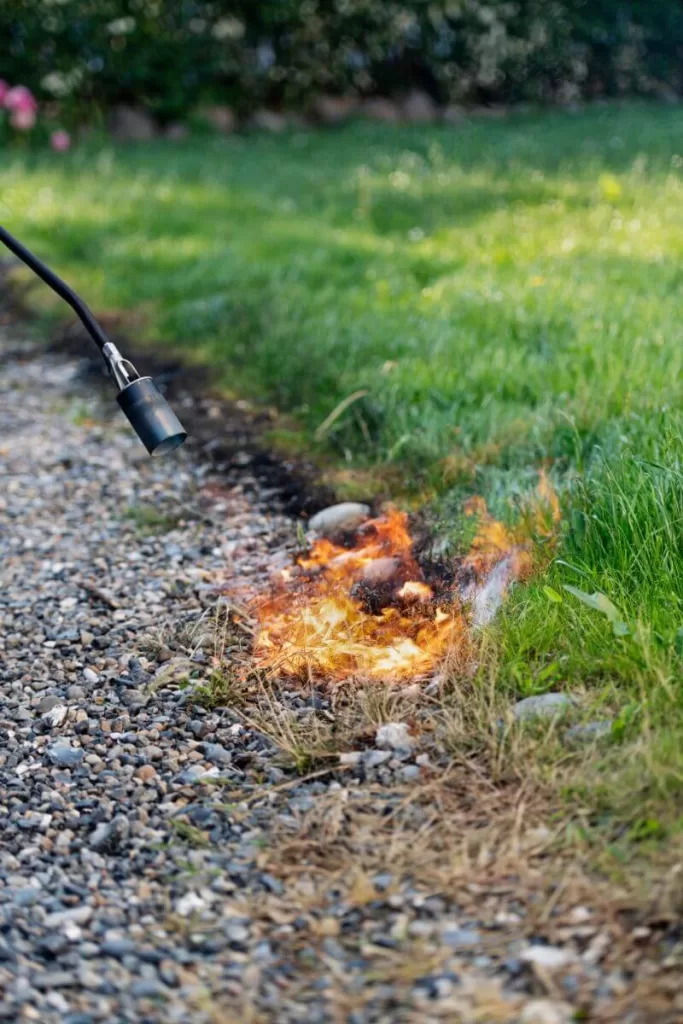Grass and weeds in a vegetable garden can get out of hand really quickly. Not only do grass and weeds steal water and nutrients from your plants, they also provide additional habits for pests. A clean, weed free garden may seem like an unattainable dream, but I have some tips for you!
The first thing to determine are you starting a new garden bed from scratch or do you already have a garden plot that has weeds in it?
Table of Contents
How to Remove Grass to Create a New Garden or Maintain a Garden
There are a couple of methods you can go about depending on the amount of time you have and the amount of space you need to remove the grass and weeds from.
Solarization
Harness the sun’s energy to get rid of grass in your vegetable garden if you have ample time. Solarization involves laying clear plastic tarps or sheeting onto your garden plot and and anchoring it well. To trap the most heat, cover the edge of the plastic sheeting with direct to ensure it has maximum contact with the top of the soil. The clear plastic stays in place and traps the moisture and heat underneath the plastic initially encouraging germination of the existing grass and weed seeds. Simultaneously the plastic sheet traps heat and uses the power of the sun to heat up the grass and weeds under the plastic, to kill gras.
The length of solarization depends upon the temperature and number of hours of direct sunlight, but generally plan for solarization to take 3 – 8 weeks to fully kill the grass in the garden area.

Occultation
While similar to solarization, occultation involves the use of opaque plastic sheeting to kill grass in the garden. Generally, people use black, silver or white plastic or vinyl tarps to place over the grass and weeds and weigh them down using sandbags, pallets, or any other heavy items on hand.
Occultation actually takes longer to kill the grass than solarization due to the fact that the opaque plastic absorbs more heat than the clear plastic and not as much heat is getting to the soil. Occultation can take 4 – 6 weeks to effectively kill the grass and weed seeds. A great source of plastic for this method would be to procure silage tarps or discarded vinyl billboard coverings.

Sod Cutter
If you’re short on time and need to remove sod from a large area, renting a sod cutter is likely your best bet. A large chain hardware store that offers equipment rental will rent these to you at a small cost. If you’re creating flower beds around your home or breaking new ground on a vegetable garden in your back yard, a sod cutter is the easiest way to remove your grass from the garden very quickly.
Hand Pulling

Has grass or weeds just taken over a small area in the garden? Hand pulling the grass and weeds is cheap and will get rid of grass and weeds if done properly. It’s best to pull weeds from moist ground and carefully pull the foliage to ensure you get the entire root. Pulling weeds before they go to seed will greatly reduce your weed seed bank over time.
Save your back by using a long handle weed claw puller you can operate by standing up.
Flame Weeding
In south Texas, we call these pear burners for using to burn the spines off of prickly pear cactus so cattle can eat the pear during times of drought. People in other parts call them propane burners or flame weeders. Attach this wand to a propane tank and carefully burn the weeds and grass growing in your garden rows. When using this tool carefully and effectively you can eliminate a lot of weeds in a relatively short amount of time. Of course, extra care is involved with this method and it should never be used close to structures, in high winds, or super tall grass.

Use a flame wheel roller like the one sold by Neversink Tools as pre-emergent control. Their inferno flame weeder rolls along your garden beds getting rid of grass in the vegetable garden before it germinates.
Manual Cultivation
One of my most used garden tools is my stirrup hoe. It has a 6″ blade that oscillates forwards and backwards allowing you to easily push and pull it around vegetable plants to remove stubborn weeds. This tool is light weight and makes quick work of weeding the garden.
Vinegar
Vinegar is a common remedy you hear people recommend for killing weeds and while it’s not the most effective way, it does work somewhat. Household vinegar is a 5% acetic acid solution and while this will burn the leaves of plants you might have better luck purchasing a stronger concentration acetic acid solution such as 15, 20 or 30 percent strength. Vinegar is caustic and should be handled with care.
Carefully pour the vinegar in a spray bottle or pump up sprayer to being treatment. Thoroughly soak the top side and underside of the weed you wish to eliminate; while this method burns the leaves, it often does not kill the root system of the weed. Vinegar’s effectiveness will depend on the type of grass or weed, it’s maturity, and strength of solution. Vinegar can also lower the pH of your garden soil, so this would not be a method you’d want to use on a regular basis. Some people use vinegar to kill grass and weeds around the perimeter of their garden and in rock areas such as the drive way.
Organic Weed Killers
Citric acid is one of the effective ingredients in Avenger Weed Killer and works by stripping away any protective covering on the plant leaves causing them to dehydrate and die. This is a non-selective killer so you need to be absolutely sure you do not spray any plants. For best results, spray Avenger on a calm, sunny day when rain is not forecasted for at least 24 hours.
Wood Chips
Did you know that many towns offer chip drops from trimming trees around the community? This is a great way to get free mulch for use in the garden. Wood chips can be applied heavily to weeded areas and will smoother out most seeds and grass from emerging. Mulch your garden pathways to prevent and kill grass. If you have tall grass, it’s recommended that you mow it very short or remove it before mulching for better results. A 4″ layer of mulch will block sunlight from reaching the unwanted grass and seeds causing them to die off and preventing germination.
Newspaper
Similar to wood chips, layers of newspaper can be laid down on top of existing grass to smother the grass and prevent sun from reaching the grass and weed seeds. Using 4 or 5 layers of newspaper watered well and topped with a layer of compost can get rid of grass in a vegetable garden. You can plant in the organic matter and the newspaper will decompose overtime putting more organic material into your soil.
Boiling Water
Another cheap way to get rid of grass is to pour boiling water on the weeds and grass you wish to eliminate. This is a great method if you only have a few clumps of grass or a few weeds you wish to eliminate. The high temperature of the hot water disrupts the cellular structure within the weed and kills it. Be sure you soak the leaves and the area around the weed to include the root systems. Of course, use extreme care and be sure not to splash yourself during the weeding process.
Corn Gluten Meal
Corn gluten meal is a by-product of milling corn and by weight consists of 60 percent of proteins that prevent seed germination and 10 percent nitrogen. Applied to cultivated soil, corn gluten meal works as a pre-emergent to prevent disturbed weed and grass seeds from germinating. It’s important to monitor weather conditions and refrain from watering to allow the corn gluten meal to work effectively. If the soil and weed seeds have constant moisture, the herbicide effects of the corn gluten meal will be ineffective allowing the weed seeds to germinate. The 10 percent nitrogen will then work as a fertilizer for the weeds and grasses that germinate.
Apply 20 pounds of corn gluten meal per 1,000 square feet of cultivated garden soil before seed germination. Apply two weeks prior to your average last frost to control summer weeds. If you’re in the southern states, repeat the process 90 days later due to our long growing season. Apply mid-September to mid-October to control winter weeds.
Corn gluten meal should only be used in garden areas where transplants will be used. Direct sown seeds will be not germinate in the treated area.
Landscape Fabric

Another method to prevent grass in the vegetable garden is to use landscape fabric. Landscape fabric can be used in your pathways or under a raised bed. The thicker the landscape fabric, the better job it will do of keeping grass out of the garden area. Landscape fabric is different than plastic sheeting as it is permeable allowing water to flow through the fabric. When applying landscape fabric, first mow the grass using the lowest setting of your lawnmower. Apply the landscape fabric using landscape staples to keep it in place.
Cover Crops
A key for getting rid of grass in the vegetable garden is to don’t let it get started to begin with. It’s important to always keep the soil covered; if your taking a gardening break plant a cover crop on your plot. A crop of southern cow peas can tolerate the high heat of summer and can be incorporated before going to seed back into your soil as green manure. When taking a break in the winter from growing vegetables, plant a cover crop of mustard or turnips instead of letting it grow up in grass or weeds.
Cover crops also prevent your soils from washing away due to erosion. Covered soil is happy soil, so keep it covered with crops or mulch as much as possible.
How to Prepare your Soil After You Get Rid of Grass in the Garden
After the removal of the grass and weeds, amend the soil with rich organic matter such as mushroom compost or aged manure. When using manure, be sure the livestock have not been fed hay that was sprayed with herbicide.
After adding your organic matter, take a soil sample to determine any additional amendments that should be applied. Your local extension agent can tell you where to send your soil sample for analysis.
Next, add your plants and mulch any areas to prevent the grass and weeds from coming back into your garden area. Some people choose to use to plant in plastic sheeting and some prefer to mulch around your plants. Mulching is an easy and cost effective method in raised beds, while plastic mulch laying machines work better for gardeners who grow in rows over a larger areas.
Tips to Prevent Weeds and Grass in the Vegetable Garden
When taking a break from gardening, plant a cover crop to improve soil health and prevent erosion. Incorporate the cover crop into your soil before it goes to seed to add organic matter to the garden area.
Overtime, the best way to control weeds and grass is to never let it get out of hand. Practice weed control methods before weeds and grasses go to seed to keep reducing your weed seed bank in the soil. Continually lowering the weed seed bank will ensure you have less weed pressure year after year.
An important tip to remember is to dispose of any weeds removed from the vegetable area. You do not want to add weeds to your compost pile where the seeds can potentially get re-spread back into your garden.
All of these various methods have pros and cons but you may try a few different ways to determine the way that best targets the grass and weeds in your garden. The important thing is to take the time during and after getting rid of the grass in the vegetable garden to build healthy soil. Healthy soil will keep your plants growing and will help keep invasive weeds from taking over the garden.


